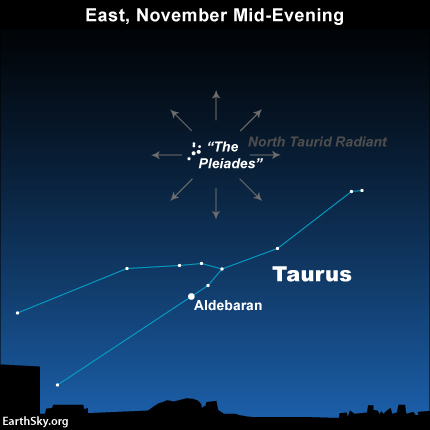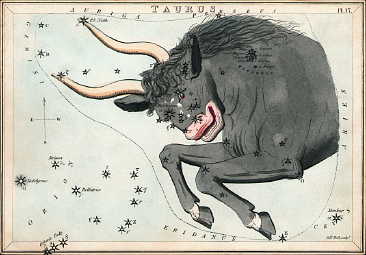

The long-last North Taurid meteor shower may reach its annual peak from around late evening on November 11, 2019, until the wee morning hours on November 12. Unlike some meteor showers, though, the North Taurids don’t exhibit a sharp peak, so the meteor rates may remain fairly steady throughout the coming week. Now here’s the bad news. The North Taurids are peaking this under the glaring light of the full moon, which comes on November 12.
In a dark sky, you might see as many as 5 meteors per hour. In a moonlit sky … we can’t estimate precisely, but you might see a few.
This shower favors the Northern Hemisphere, but no matter where you live worldwide, the best viewing hours are usually in the wee hours just after midnight. The year, as the shower peaks in 2019, moon will be up high and shining mightily around the midnight hour, bleaching out these meteors. A high percentage of Taurid meteors do tend to be fireballs, or especially bright meteors. Let’s hope a few Taurid fireballs can overcome the moonlight!
November 2019 guide to the five visible planets
The North Taurid meteors derive their name from the constellation Taurus the Bull. If you trace the paths of the Taurid meteors backward, you’ll see they appear to radiate from near the famous Pleiades star cluster of this constellation on the peak nights of the North Taurid meteor shower.
You don’t have to find Taurus, though, to watch the North Taurid meteors. These slow-moving meteors can light up any part of the starry heavens, streaking through a wide variety of constellations.
So just lie back comfortably and gaze in all parts of the sky, while waiting for the Taurid meteors.
Easily locate stars and constellations during any day and time with EarthSky’s Planisphere.

Taurid meteor seen by Ken Christison in Conway, North Carolina on November 8, 2012. See the V-shaped face of the Bull in Taurus, and the very bright planet Jupiter nearby?
On a moonless night, a dark sky highlights the Bull – the radiant point for the North Taurid meteors – in all his starlit majesty. Taurus contains many noticeable stars – plus two star clusters – and is pretty easy to spot. The Bull appears over the eastern horizon by around 8 p.m. and is highest up in the sky around 1 a.m.
The Bull’s face consists of a V-shaped star cluster called the Hyades cluster. The Bull’s fiery red eye – the star Aldebaran – is not part of the Hyades. This ruddy star lies in the same direction, though at only about half the distance to the Hyades cluster.
The star Elnath marks the tip of the Bull’s northern horn.
And the Pleiades star cluster marks the Bull’s shoulder.
The radiant point of this shower soars to his highest point for the night around 12:30 a.m. local time. That’s why the meteors are best around then.
Taurus descends westward throughout the morning hours, and is found over the western horizon by daybreak.

Meteor flies by constellation Orion. At top left of photo, planet Jupiter and star Aldebaran highlight constellation Taurus, near the radiant point of this weekend’s meteor shower. Allen Lefever captured this meteor in November 2012.
Bottom line: The year 2019 finds the slow-moving North Taurid meteors having to compete with moonlight, as this shower reaches its peak on the night of November 11-12.
Read more: Full moon subdues North Taurid meteor shower peak
Source:
https://earthsky.org/astronomy-essentials/north-taurid-meteors-on-november-nights
